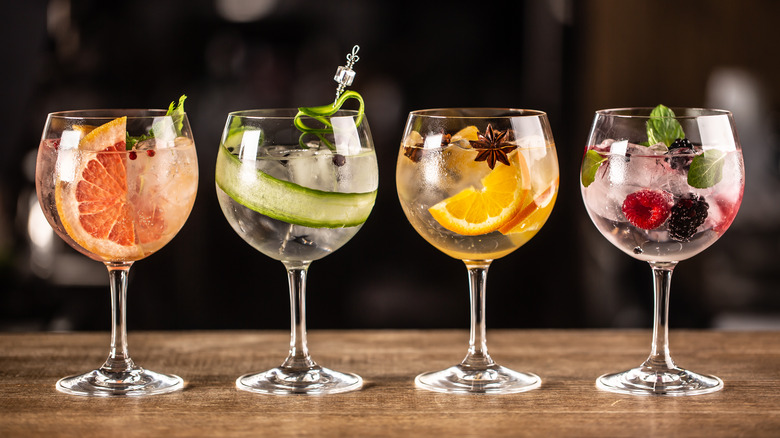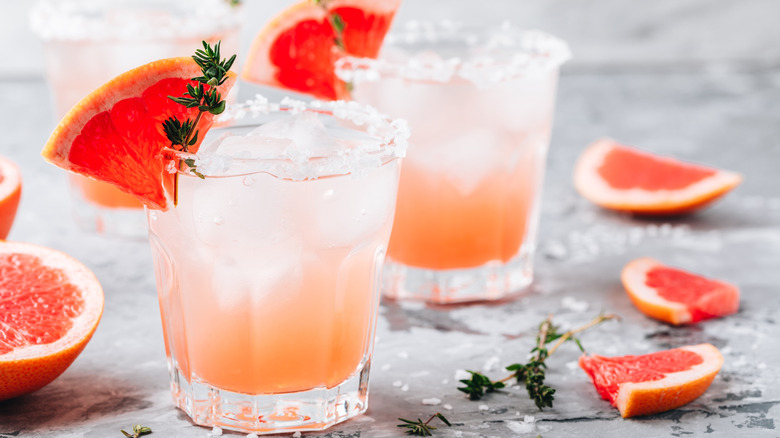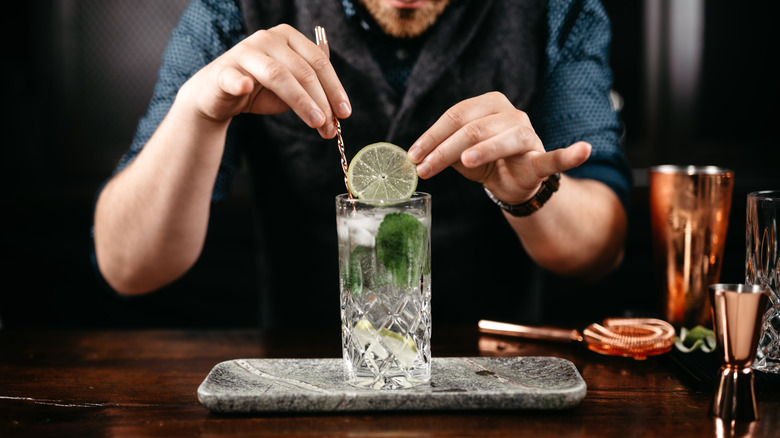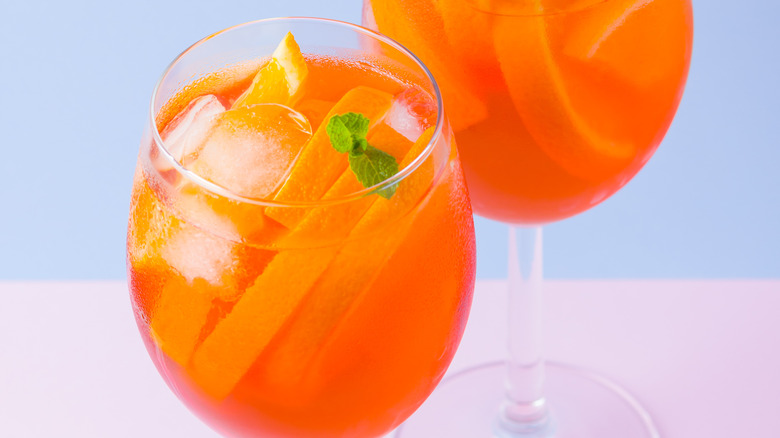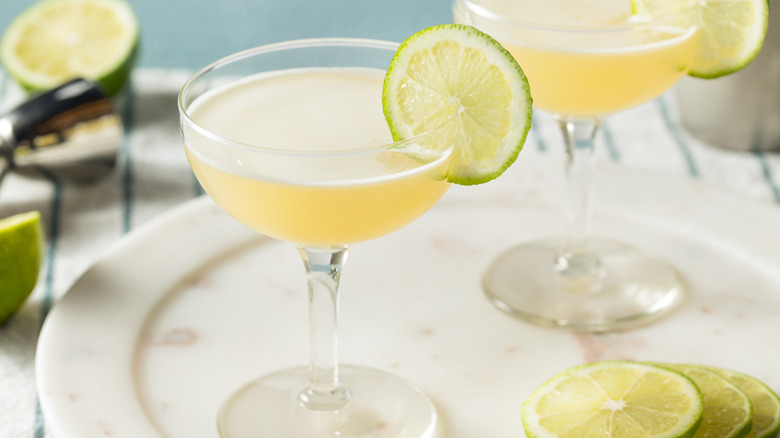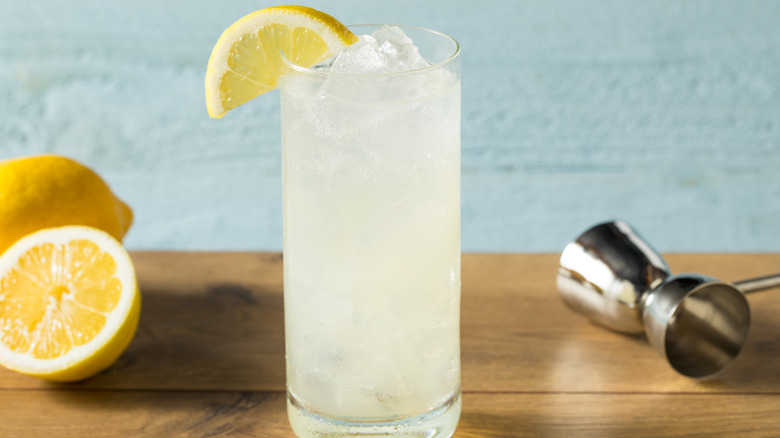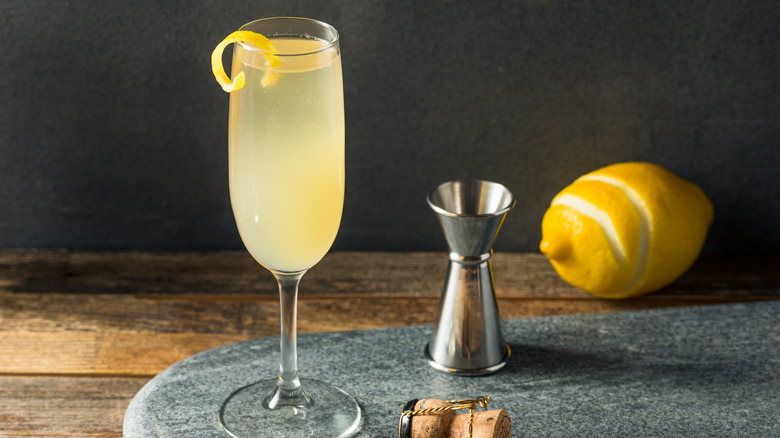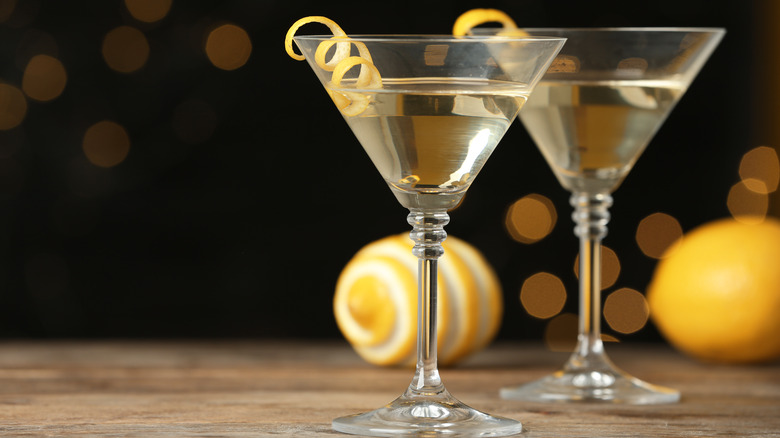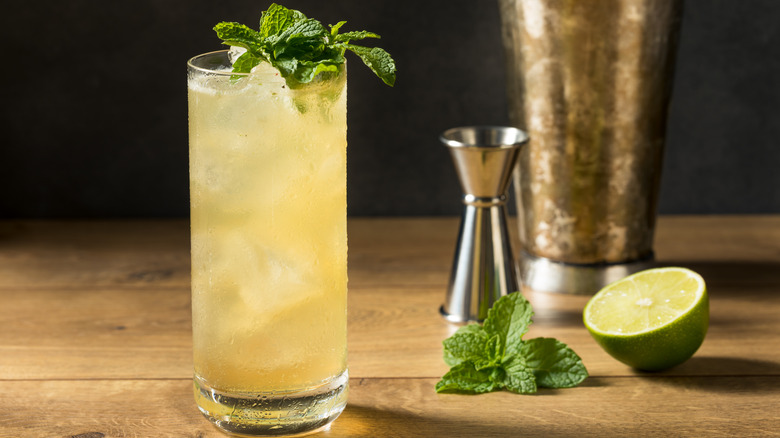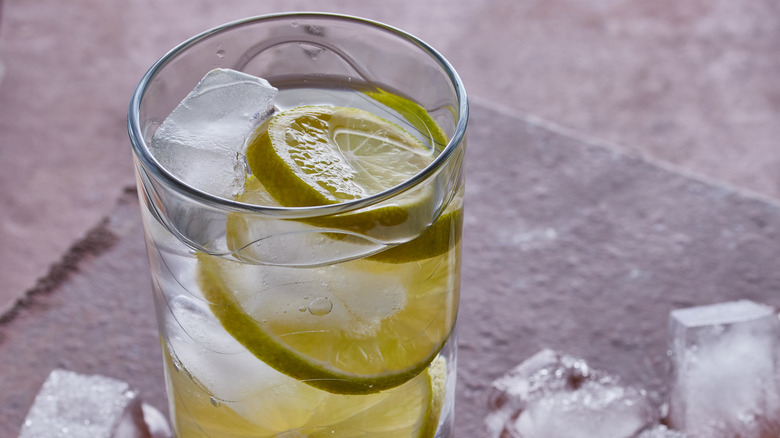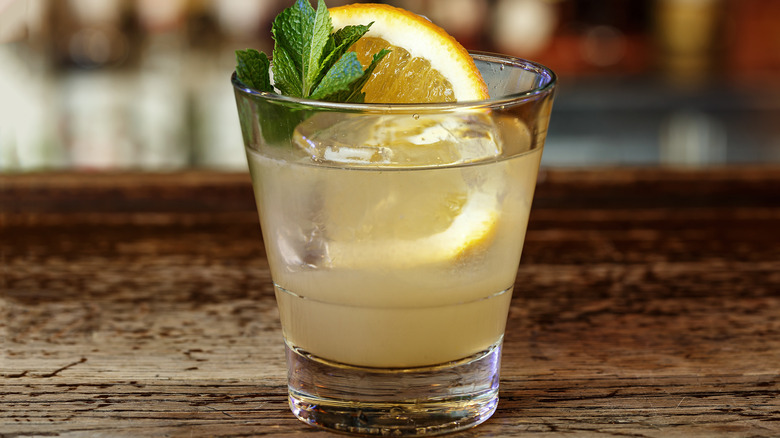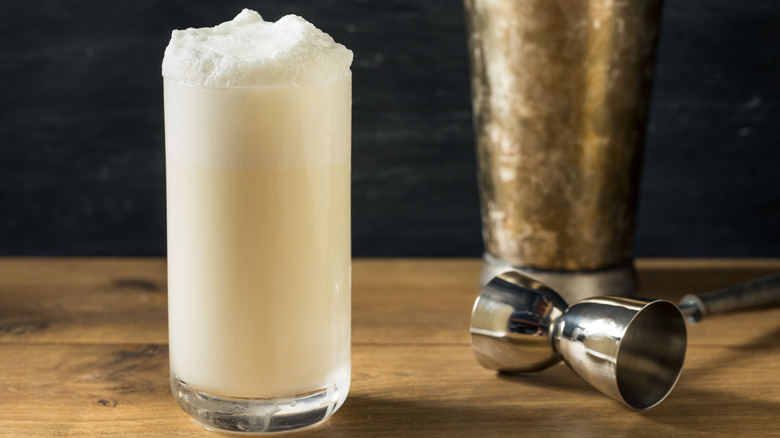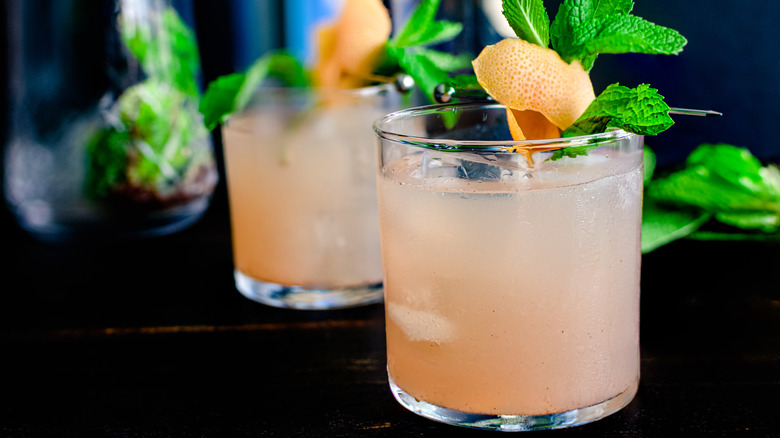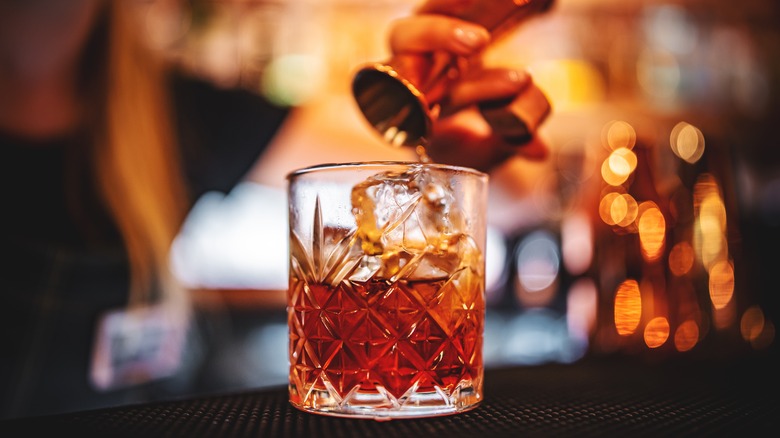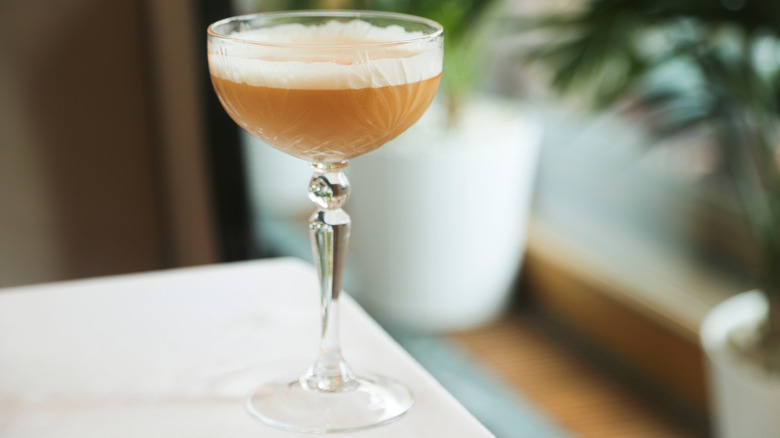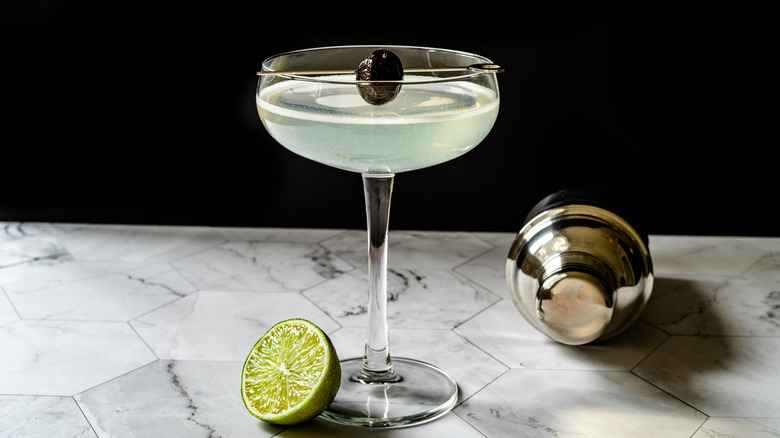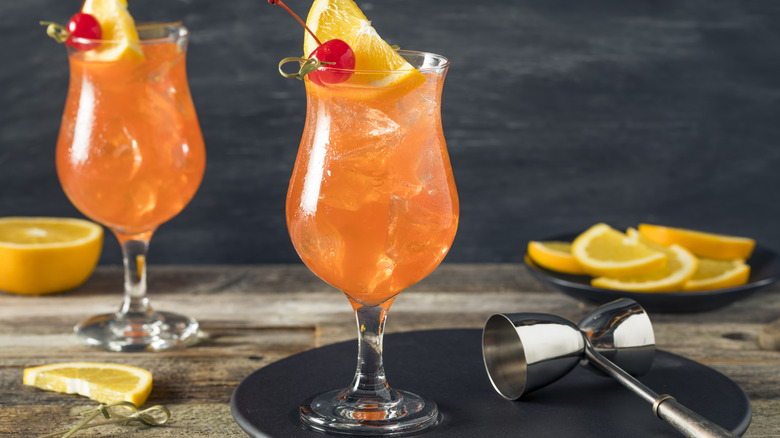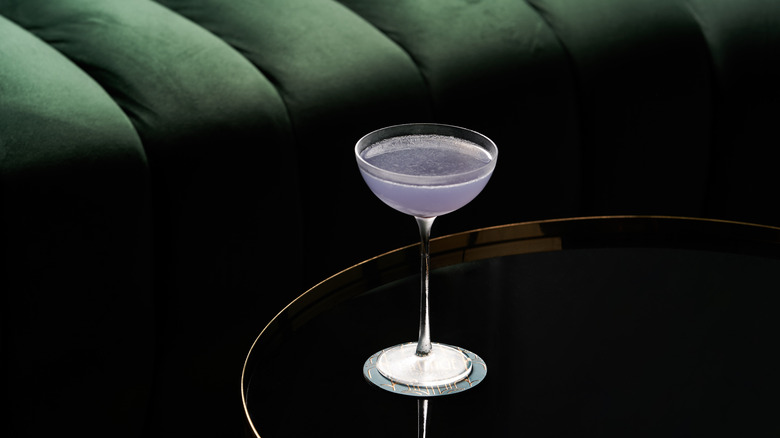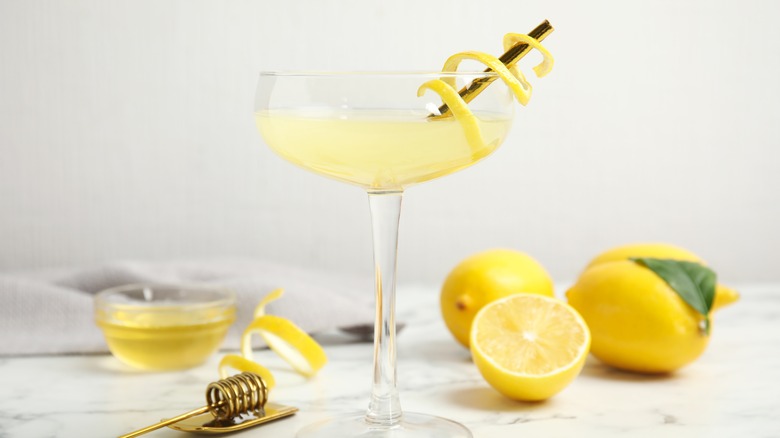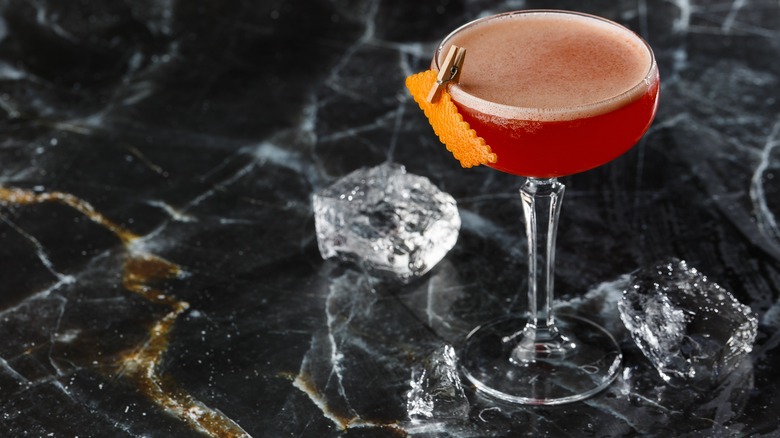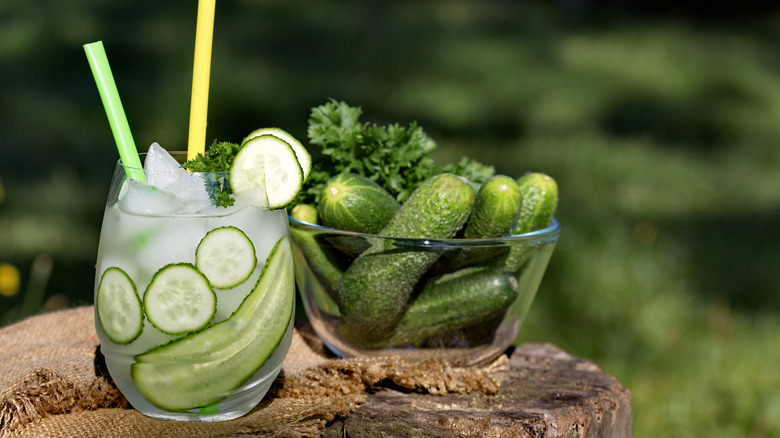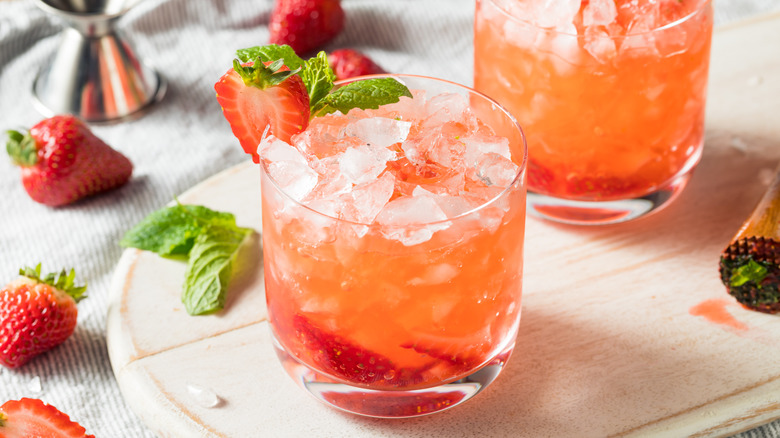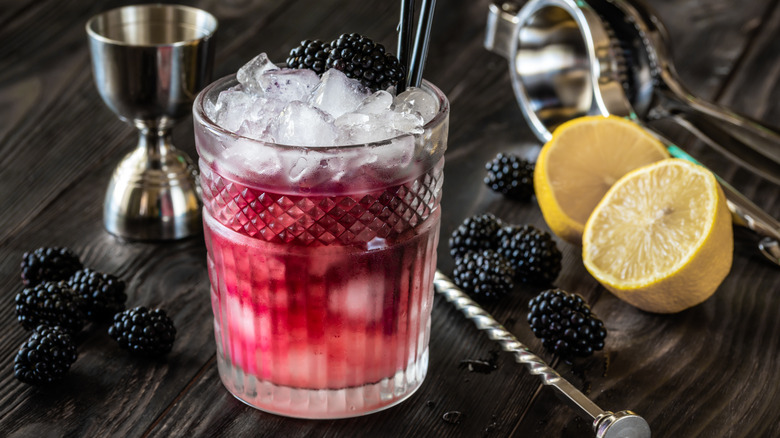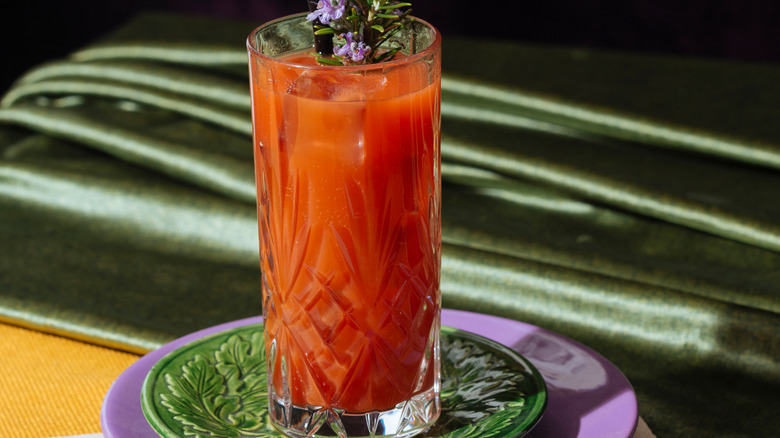23 Cocktails To Try If You Like Drinking Gin
Gin is clear liquor that packs a pretty astounding amount of flavor into a small glass. It's a neutral grain spirit distilled with juniper and botanicals that has a predominantly piney flavor, but it doesn't stop there.
It's similar to vodka, in that they're both light spirits. But while vodka has no taste, gin is distinctively botanical. There are many varieties of gin, and each distiller makes its own unique take on the liquor that goes beyond juniper (though that's a pretty standard hallmark of gin regardless). For example, MKT Distillery in Katy, Texas makes a Texas gin with a dialed back juniper flavor and a citrus component featuring ruby red grapefruits, Texas mint, lime, and pecan – along with juniper, of course. The result is a flavor profile that's half citrus, half floral, and entirely unique.
Like the spirit itself, gin cocktails can be just as varied, though many feature similar flavor profiles of citrus fruits, mint, and a touch of sugar. Gin cocktails are often light, refreshing, and a little bit sweet — the perfect drink for summer or, really, any time of year. Read on to find some classic gin favorites and a few new cocktails that you'll want to try.
1. Salty Dog
The Salty Dog is quick and easy to mix up, making it perfect for an on-the-fly cocktail that focuses on simple but high-quality ingredients. It's basically gin and grapefruit juice with a couple of garnishes. And don't skimp on those garnishes either; for instance, the salt on the rim helps to balance out the sourness and bitter edge of the grapefruit. Generally, a dry gin works best for this drink. Sweeter gins or gins with a lot of added flavorings might overpower the complex flavors of this cocktail.
At MKT Distillery, distiller Nici Cowan-Jessett keeps it simple with the Distillery Dog that's a mix of gin and grapefruit juice. You can use fresh or prepared grapefruit juice. If you're squeezing your own grapefruit juice, you'll need about one grapefruit per drink, and darker flesh will offer the most sweetness. Ruby red grapefruits are the sweetest while white is less sweet.
To make this drink, first rim a glass with salt, then mix two parts grapefruit juice to one part gin. Stir, then garnish with a wedge of grapefruit or other citrus fruit.
2. Gin and tonic
Ah, the classic gin and tonic. This drink has a real pedigree, including some true-blue medicinal roots. Fever-Tree – which makes tonic water and other cocktail mixers — explains that British soldiers stationed in India got a daily ration of gin and also had medicinal doses of quinine water used to protect against malaria. Quinine was sourced from the bark of a tree, hence the company name. As the story goes, soldiers would mix the two in the drink we now know as the gin and tonic, or G&T for brevity's sake.
Though it's another extremely simple gin cocktail, don't dismiss the gin and tonic. It consists of ice, gin, tonic water, and a twist of lime. It's all very easy to keep on hand and ready to go when the mood strikes. But, given that it presents somewhat of a blank slate, feel free to dress the drink up a bit as the mood strikes you. The Jessetts at MKT Distillery make their version of the gin and tonic with lime, mint, a cucumber slice, and a sprig of rosemary.
To make your own basic gin and tonic, fill a glass with ice — the more the better. Mix three parts tonic water with one part gin. Peel off some lime zest, squeeze it over the glass to release the oils, and then drop the lime into the glass.
3. The #1 crush
Do you love rosé wine but want to mix it up a bit from time to time? A refreshing gin cocktail offers a new way to get your fix of rosé with a new botanical edge. With lemon and fresh orange juices, this rosé cocktail recipe with gin and Campari, popularly known as the #1 crush, is a tasty way to squeeze in a serving of citrus fruits, too.
Nicky's Coal Fired in Nashville, Tennessee makes this drink with gin (or vodka), rosé wine, Campari, and strawberries. It's a light and refreshing spritzer cocktail with a lot of flavors and a seriously alluring color. It's also perfectly refreshing for the warm days of spring and summer.
To make this drink yourself, combine 1 ½ ounces dry gin, ½ ounce Campari, ½ ounce honey, ¾ ounce fresh lemon juice, and ½ ounce fresh orange juice in a cocktail shaker with ice. Shake it and pour it into a new glass over fresh ice. Add a splash of sparkling rosé, then garnish the rim with an orange slice.
4. Gimlet
A gimlet is a classic gin cocktail made with gin, fresh lime juice, and simple syrup. If you have your simple syrup ready to go ahead of time, it's a snap to pull this refreshing cocktail together in just a couple of minutes. It's a little sweet, tart, and acidic all at once, bringing a nice complexity to a cocktail world that often tends toward the super sweet.
To make simple syrup, you simply need to combine a cup of water and a cup of sugar in a small saucepan. Bring this mixture to a boil and stir until the sugar is dissolved and the mix in the pot is clear. Then bring the heat down to a simmer, give it a stir, and remove the pot from heat and allow it to cool.
To make a gin gimlet, combine two parts gin, one part fresh lime juice, and one part simple syrup in a cocktail shaker with ice and shake it up. Strain and pour over ice, then add a sliced lime for garnish.
5. Tom Collins
Who is Tom Collins, anyway, and why is there a drink named after him? The fact is that there is no Tom Collins, according to Ozy. There was a running joke, though, that likely led to the genesis of this drink's name. As the story goes, bar patrons would walk into a bar only to be greeted with a warning that Tom Collins had a bone to pick. The especially gullible might get pretty steamed, thinking some person they'd never met was walking around causing trouble for them. But Tom Collins never materialized to make good on that fight, simply because he didn't exist. This weird joke from the 19th century didn't really stick around, but the drink named after him sure did.
This classic gin cocktail combines gin, lemon juice, simple syrup, and club soda. And like many gin cocktails, it offers a great way to cool off and refresh on a hot day. To create this drink, in a glass, combine two parts gin with one part freshly squeezed lemon juice and half a part of simple syrup. Then fill it with ice, top it off with club soda, and stir. Add lemon to garnish and an optional cherry on top if you're feeling fancy. Even Tom Collins himself would approve.
6. French 75
If you're looking for a gin cocktail that's both strong and festive, a French 75 will fit the bill. Made with gin and champagne, it's got the alcohol content and botanical flavor of gin, paired up with the tart sweetness of lemon and the sparkle of some delightfully bubbly wine. Topped with a twist of lemon, it's light and delicious but packs a better punch than Champagne alone.
You'll need simple syrup for this recipe, which you can buy premade or simply make your own at home with a 50/50 mix of sugar and water on the stovetop, or else by blending the same ratio of honey to the water.
Here's how to make it: First, fill a cocktail shaker with ice, then combine 1 ½ ounces of gin, ¾ ounce of fresh lemon juice, and ¾ ounce simple syrup. Shake, then strain into a Champagne flute and top it off with, of course, some Champagne. Peel off a thin slice of lemon peel and then garnish your glass with this twist of lemon.
7. Vesper martini
Made famous by James Bond, 007's signature drink is named after the double agent Vesper Lynd and featured in the book and movie "Casino Royale." It's famously shaken, not stirred. Meanwhile, the ice serves to dilute the high-octane drink and add some chill.
It's described in "Casino Royale" by 007 himself thusly: "Three measures of Gordon's, one of vodka, half a measure of Kina Lillet. Shake it very well until it's ice-cold, then add a large thin slice of lemon peel. Got it?" (via "Vodka Distilled").
While you might think of the Vesper martini as primarily a gin martini, it features vodka, too, which helps to dial back some of the botanical taste of the gin. If you're new to drinking gin cocktails or just want something with a less herbal flavor, then the Vesper martini may be perfect for you. Made of gin, vodka, and vermouth, it's still a rather stiff, yet sophisticated drink.
To make a Vesper martini, first fill a cocktail shaker with ice, then combine 3 ounces of gin, 1 ounce of vodka, and ½ ounce Lillet Blanc or dry vermouth. Shake — don't stir — the mixture and strain it into a martini glass. Garnish with lemon peel. Dodge bullets as necessary.
8. Gin-gin mule
Mules aren't just for Moscow. The versatile ginger-lime mule can swap in gin, bourbon, and other spirits rather than vodka, often with intriguing results. That's what Pegu Club in New York City has done with one of their signature drinks, known as the gin-gin mule (via James Beard Foundation). This cocktail features gin instead of vodka, which plays well with the intense ginger flavor.
It's fun it's you're making a mule flight or just trying out different versions of the mule. This fresh cocktail features lime juice, simple syrup, mint, gin, and ginger beer – you can step up the ginger factor with a candied ginger garnish.
To make a gin-gin mule, first combine ¾ ounce fresh lime juice, 1 ounce of simple syrup, and a sprig of mint in a highball glass, then muddle well. Add 1¾ ounces gin, 1 ounce of ginger beer, and ice. Garnish with mint, lime, and candied ginger.
9. Gin Rickey
Unlike the Tom Collins, the gin Rickey is actually named after a real person. According to Difford's Guide, the gin Rickey was created in 1880 at a Washington, D.C. bar after bartender George A. Williamson saw Colonel Joseph Kyle Rickey squeeze a lime into his whiskey and then top the resulting mixture with some soda. Rickey later purchased the bar and, perhaps unsurprisingly to astute observers like Williamson, became a major U.S. lime importer.
Though similar to the Tom Collins, a gin Rickey is made with lime juice, not lemon and it should be served in a shorter glass than its cocktail cousin. Like many gin cocktails, the gin Rickey is potent but light, featuring flavors of citrus and botanicals from both the namesake liquor and its lime.
How to make it: Combine 1 ½ ounces dry gin, ½ ounce freshly squeezed lime juice, and ⅓ ounce sugar syrup (a sugar syrup is like a simple syrup, but is made with a 2-to-1 ratio of sugar to water) in a cocktail shaker filled with ice. Shake, then strain into a glass filled with ice. Top it off with ½ ounce of soda water.
10. Southside
Like many gin drink recipes, the Southside is a simple gin cocktail featuring familiar ingredients, namely gin, mint, citrus, and simple syrup. But this gin cocktail dials it up a notch with a few key tweaks. These include some optional spiced gin, a much heavier mint presence, and cocktail bitters. The result is a lightly sweet, full-flavored gin cocktail.
There's some disagreement over where exactly the Southside cocktail originated. According to Epicurious, it may have come from the Southside Sportsmen's Club on Long Island, or it could have originated somewhere on the Chicago South Side during the Prohibition era. There's even the 21 Club in Manhattan that claims the drink as its original creation.
While you ponder the genesis of this drink, go ahead and make one in order to contemplate its taste as well. To make a Southside, combine 2 ounces spiced gin, 1 ounce freshly squeezed lime juice, 3/4 ounce simple syrup, up to 10 fresh mint leaves, and two dashes of Angostura cocktail bitters in a cocktail shaker filled with ice. Shake, then double strain into a glass. Garnish it with a mint leaf.
11. Ramos gin fizz
A Ramos gin fizz is a creamy, bubbly New Orleans classic that requires a bit of a workout to prepare. To craft your own gin fizz at home, combine in a cocktail shaker filled with ice 2 ounces gin, ½ ounce freshly squeezed lemon juice, ½ ounce freshly squeezed lime juice, ½ ounce freshly squeezed lemon juice, an ounce heavy cream, a teaspoon of orange flower water, and an egg white for the drinks signature frothy top.
Vigorously shake, shake, then shake some more — around 30 seconds will do the trick. Have a Collins glass ready with an ounce of soda water (you can't forget the fizzy part). If you're squeamish about using egg whites in your cocktail, don't worry, it's safe and doesn't impart any eggy flavor.
12. Greyhound Cocktail
Made from grapefruit juice and gin (or, ahem, vodka), the Greyhound cocktail supposedly got its name because it was a popular drink at Greyhound bus terminals. If true, this bit of information begs all kinds of questions, such as: Wait, what!?
There may not be much mixology going on at the Greyhound bus stations we've been to, but this classic cocktail lives on. The drink as we know it was first described by "The Savoy Cocktail Book," which was published in 1930. In 1945, Harper's magazine officially dubbed it the "greyhound" (via Masterclass). The drink only contains two ingredients — juice and spirit — and it comes served in many different glasses.
With a simple-but-winning formula as its base, the Greyhound is a popular cocktail for riffing on by modern mixologists. For a brunch-y take on the cocktail, try the Earl Greyhound Fizz — with Earl Grey tea, honey and seltzer water. If you want a chef-y spin, the Greyhound(ed) cocktail uses the smoky juice of brulé-ed grapefruit halves.
13. Negroni
Like the Cosmopolitan in the '90s and the Mojito in the '00s, the Negroni has been the trendy tipple of the past decade or so. If you've been to a craft cocktail bar in the past ten years, dollars to donuts, you've seen somebody drinking one. Made with gin, sweet vermouth, and a bitter liqueur called Campari, the origin of the Negroni cocktail can be traced to 1919 in a bar in Florence, Italy. Count Camillo Negroni was looking to level-up the Americano cocktail of sweet vermouth, Campari, and soda water, when he asked a bartender to swap gin for soda. For decades after, the Negroni developed a cult following around the world.
The Negroni isn't exactly the most glug-able cocktail. So why did it become so popular? Most likely, the rise of craft cocktail culture and associated use of bitters gave people more of an appreciation for bitter flavors in their drinks. Also, with its amber hue and citrus garnish, pictures of the Negroni are definitely like-worthy on social media.
The Negroni is another cocktail that lends itself well to variations. A frozen Negroni recipe calls for blending the drink with ice. A Negroni with sparkling wine dials down the ABV and dials up the effervescence.
14. Earl Grey MarTEAni
The heady times of the early 2000s craft cocktail revival saw the creation of many great drinks, and one of those creations was the Earl Grey MarTeani. Audrey Saunders, a craft cocktail luminary of those times, developed this novel drink around 2003 for her iconic Pegu Club in New York City (via Robb Report).
More than the sum of its parts, the Earl Grey MarTEAni is made with lemon juice, simple syrup, an egg white, and gin infused with Earl Grey tea. The beauty of this cocktail is the way the egg whites tamp down tannins from the tea. Left unchecked, "the tannins in tea, alone, can build up on your palate and exhaust it," Saunders told The New York Times. The egg whites and the Earl Grey MarTEAni bind the tannins, taming their astringency and keeping the palate engaged. If you're skeptical about drinking egg whites, the Earl Grey Punch recipe from our test kitchen delivers similar notes with almost zero risk of salmonella exposure.
15. The Last Word
The story of The Last Word is inextricably entwined with the spirit that gives the cocktail its signature green color: Chartreuse. While this article isn't the place to cover everything you didn't know about Chartreuse, suffice it to say that it was developed by Carthusian monks in the 19th century and is made from 130 different herbs and spices (via Old Liquors Magazine).
Chartreuse begins by distilling a Brandy-type spirit over the course of seven hours in copper stills. Herbs are first infused during distillation, and a secondary infusion occurs during three weeks of maceration. After that, the resulting liquid is aged in oak barrels before being bottled.
Along with gin, lime, and Maraschino liqueur, Chartreuse was used to develop The Last Word cocktail in the early 20th century. One hundred years later, the craft cocktail revival of the early 2000s would elevate this drink to unprecedented popularity. In fact, during the COVID-19 pandemic, The Last Word was one of the most popular cocktails to make during quarantine.
16. Singapore Sling
Widely considered part of the tiki cocktail canon, the Singapore Sling is unusual in that it's based on gin, not rum. Also made with cherry liqueur, pineapple juice, lime juice, and grenadine, the Singapore Sling can be a fun, juicy escape from the typical citrus, herbal, and bitter cocktails with which gin is usually associated.
The Singapore Sling also differs from many tiki drinks in that it was actually developed on a Pacific island — at the Raffles hotel in Singapore. According to the Raffles Singapore official website, the drink was developed at hotel's Long Bar in 1915 by bartender Ngiam Tong Boon. Social etiquette in Singapore at the time dictated that women were not allowed to consume alcohol in public. Instead, they would drink tea or fruit juice. Seeing an opportunity to sell drinks while flying under the social etiquette radar, Ngiam created the bright red Singapore Sling.
Over the years, the Singapore Sling grew in popularity. During the Vietnam War, U.S. servicemen would often take their leave on the island nation, and the drink was eventually brought back to the United States. Today, the Singapore Sling can be found in some of the best tiki bars in the U.S.
17. Aviation
Once considered a "secret handshake" among mixologists in the early days of the 2000s craft cocktail revival, the Aviation cocktail has supposedly lost a bit of shine in recent years. However, it's still considered a staple craft cocktail in many bars.
Made with gin, lemon juice, and maraschino liqueur, the Aviation's early aughts allure came from its fourth and most defining ingredient: crème de violette. American mixologists looking to recreate the pre-Prohibition classic had a hard time sourcing the floral, purple liqueur, which gave the drink its White Whale aura. Once American importer Haus Alpenz started bringing in Rothman & Winter Crème de Violette from Austria, the Aviation became far more accessible for craft cocktail bars, and the drink took off (via Punch). Like many things that achieve ubiquity, there was a subsequent backlash among the cocktail cognoscenti, and the Aviation has dropped off in popularity significantly. But that doesn't mean you shouldn't give this botanical use of gin a try.
18. Bee's Knees
Made with gin, lemon, and honey, the Bee's Knees cocktail isn't one of the most cleverly named cocktails. But when made correctly, it can be deliciously elegant in its simplicity.
This classic cocktail was likely developed like most Prohibition-era cocktails: as an easy way for speakeasies to mask the off-flavors of bathtub and bootleg gin. One of the first printed recipes for the Bee's Knees cocktail appeared in a 1930 cocktail book by Bill Boothby called "World Drinks and How to Mix Them" (via Paste Magazine). Another recipe appeared in the 1936 printing of a cocktail book called "The Artistry of Mixing Drinks" by Frank Meier. Whether Boothby or Meier is the original creator of the Bee's Knees is still a subject for debate.
Because it contains so few ingredients, getting the ratios correct and using a good gin are essential when making the Bee's Knees. There are gins made with raw honey, and these are a natural fit for this classic cocktail.
19. Clover Club
While we tend to think of cocktails as a space free from socio-political issues, drinks aren't exempt from preconceived notions, especially those around gender and masculinity. Case in point: The pink-hued Clover Club cocktail — made with gin, lemon juice, and raspberry syrup — was developed as a signature drink for a high society gentleman's club of the same name.
In the late 19th and early 20th centuries, pink was a fashionable color for the worldly gentleman (via Chilled). To wit, F. Scott Fitzgerald has Jay Gatsby wear a pink suit as a kind of status symbol in his iconic book, "The Great Gatsby." However, perceptions around pink changed over time, and the once-sophisticated Clover Club cocktail slowly became seen as a "girl drink," which any red-blooded man wouldn't dare be caught daintily sipping.
Of course, the idea that "real men" can't drink pink drinks is ridiculous. It's also increasingly out of step with the times. One of the most popular flavored vodkas today is New Amsterdam's Pink Whitney, which was developed by former professional hockey players — and all-around tough guys — Ryan Whitney and Paul Bissonnette.
20. Cucumber Cooler
With all of the syrups, bitters, shrubs, tinctures, and other cocktail ingredients on the market, it's easy to lose sight of simple, refreshing drinks like the Cucumber Cooler. Widely available, cucumbers may not be very exotic, but adding them to drinks has a transformative effect, instantly making them more refreshing and slightly vegetal. In the Cucumber Cooler cocktail, cucumber slices are added to gin, lime juice, sugar, mint, and club soda. The result is a very drinkable cocktail that goes perfect with a summer afternoon.
This simple but elegant drink also lends itself to a number of different interpretations. One riff from Southern Living adds jalapeño chilies for a spicy kick. Another one from Martha Stewart adds watermelon to up the refreshment ante. Adding strawberries to the mix gives the Cucumber Cooler a berry-focused spin (via Louisiana Cookin').
The type of cucumber you use will also have an impact on the final product. You may not think so, but there is a difference between Persian and English cucumbers that goes beyond length. Chose whatever cucumber speaks to your tastes.
21. Strawberry Gin Smash
If a drink recipe has the word "smash" in it, consider it a trigger warning: Fruit will be harmed in the making of this cocktail. Actually, the original incarnation of a smash was just liquor, sugar, and ice. But over time, the smash evolved to include muddled fruit.
Muddling involves technique, and you're muddling your cocktails all wrong if you are pounding the fruit into submission like a WWE wrestler. The correct way to muddle is to use a twisting motion, as pounding motion could release bitter notes, especially from herbs. You should also be using a wooden or bamboo muddler, not a metal one, in order to avoid excessive bruising.
The making of a Strawberry Gin Smash starts by adding lime juice and strawberries to a glass, which are then muddled. Gin and tonic water are added, and then the drink is gently stirred. Final touches could include a garnish of mint leaves or a sugared rim.
22. Bramble
The Bramble is a classic cocktail that might seem like another pre-Prohibition revival, but the drink actually has origin in 1980s London. Bartender Dick Bradsell developed the Bramble while working at Fred's Club, an exclusive club that counted Boy George, Naomi Campbell, and other celebrities as its members (via Difford's Guide).
Bradsell said the Bramble was partly inspired by tasting crème de mûre, a blackberry liqueur that reminded him of picking blackberries as a child on the Isle of Wight. He also said he was inspired by the composition of the Singapore Sling, which is made with gin, lemon, sugar, and cherry liqueur.
The result of these inspirations is a riff on a Singapore Sling that features Western European ingredients. First — gin, lemon juice, simple syrup, and ice are added to a rocks glass and stirred. Then, more ice is added, and the glass is laced with crème de mûre to create a "bleeding effect."
23. Red Snapper
The Red Snapper cocktail was created in the 1930s by Fernand "Pete" Petiot as a riff on the Bloody Mary, a drink he quite possibly also created. While the Bloody Mary is made with vodka, the Red Snapper supposedly features gin because Prohibition made Russian vodka more difficult to acquire for American bartenders at the time.
According to legend, Petiot developed the Red Snapper while working at the King Cole Bar at the St. Regis New York Hotel in New York City. The name Red Snapper was actually preferred over the name Bloody Mary by the hotel's owners — the prestigious Astor family — because the latter was deemed too vulgar.
Regardless of its origins, the Red Snapper is a more flavorful spin on the Bloody Mary, given that gin is simply vodka with the addition of numerous botanicals. Juniper and other gin ingredients are a natural fit with tomato juice, Worcester sauce, lemon juice and other classic Bloody Mary ingredients.
